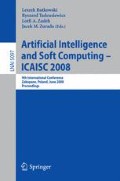Abstract
This paper focuses on classification tasks. The goal of the paper is to propose a framework for adaptive and integrated machine classification and to investigate the effect of different adaptation and integration schemes. After having introduced several integration and adaptation schemes a framework for adaptive and integrated classification in the form of the software shell is proposed. The shell allows for integrating data pre-processing with data mining stages using population-based and A-Team techniques. The approach was validated experimentally. Experiment results have shown that integrated and adaptive classification outperforms traditional approaches.
Access this chapter
Tax calculation will be finalised at checkout
Purchases are for personal use only
Preview
Unable to display preview. Download preview PDF.
References
Aksela, M.: Adaptive Combinations of Classifiers with Application to On-line Handwritten Character Recognition. Ph.D., Department of Computer Science and Engineering, Helsinki University of Technology, Helsinki (2007)
Barbucha, D., Czarnowski, I., Jȩdrzejowicz, P., Ratajczak-Ropel, E., Wierzbowska, I.: JADE-Based A-Team as a Tool for Implementing Population-Based Algorithms. In: Chen, Y., Abraham, A. (eds.) Proceedings of the Sixth International Conference on Intelligent Systems Design and Applications (ISDA 2006), vol. 3, pp. 144–149. IEEE Computer Society Press, Los Alamitos (2006)
Bull, L.: Learning Classifier Systems: A Brief Introduction. In: Bull, L. (ed.) Applications of Learning Classifier Systems (2004)
Bull, L., Kovacs, T.: Foundations of Learning Classifier Systems: An Introduction. Foundations of Learning Classifier Systems. Springer, Heidelberg (2005)
Bhanu, B., Peng, J.: Adaptive Integration Image Segmentation and Object Recognition. IEEE Trans. on Systems, Man and Cybernetics 30(4), 427–441 (2000)
Czarnowski, I., Jȩdrzejowicz, P.: An Approach to Instance Reduction in Supervised Learning. In: Coenen, F., et al. (eds.) Research and Development in Intelligent Systems XX, pp. 267–282. Springer, London (2004)
Czarnowski, I., Jȩdrzejowicz, P.: An Agent-Based Algorithm for Data Reduction. In: Bramer, M., et al. (eds.) Research and Development in Intelligent Systems XXIV and Applications and Innovations in Intelligent Systems XV, pp. 351–356. Springer, London (2008)
Czarnowski, I., Jȩdrzejowicz, P.: Data Reduction Algorithm for Machine Learning and Data Mining. In: Nguyen, N.T., et al. (eds.) IEA/AIE 2008. LNCS (LNAI), vol. 5027, pp. 276–285. Springer, Heidelberg (2008)
Duch, W.: Results - comparison of classification. Nicolaus Copernicus University (2002), http://www.is.umk.pl/projects/datasets.html
Dash, M., Liu, H.: Feature Selection for Classification. Intelligence Data Analysis 1(3), 131–156 (1997)
Frawley, W.J., Piatetsky-Shapiro, G., Matheus, C.: Knowledge Discovery in Databases - An Overview. In: Piatetsky-Shapiro, G., Matheus, C. (eds.) Knowledge discovery in databases. AAAI/MIT Press (1991)
Glover, F.: Tabu Search. Part I and II, ORSA Journal of Computing. 1 (3), Summer (1990) and 2 (1) Winter (1990)
Han, J., Kamber, M.: Data Mining. In: Concepts and Techniques. Academic Press, San Diego (2001)
Holland, J.H.: Adaptation. In: Rosen, Snell (eds.) Progress in Theoretical Biology, vol. 4, Plenum (1976)
Jȩdrzejowicz, P.: Social Learning Algorithm as a Tool for Solving Some Difficult Scheduling Problems. Foundation of Computing and Decision Sciences 24, 51–66 (1999)
Krawiec, K.: Konstruktywna indukcja cech we wspomaganiu decyzji na podstawie informacji obrazowej. Rozprawa doktorska. Instytut Informatyki Politechniki Poznanskiej, Poznan (2000) (in Polish)
Meiri, R., Zahavi, J.: Using Simulated Annealing to Optimize the Feature Selection Problem in Marketing Applications. European Journal of Operational Research 17(3), 842–858 (2006)
Merz, C.J., Murphy, P.M.: UCI Repository of Machine Learning Databases. University of California, Department of Information and Computer Science, Irvine, CA (1998), http://www.ics.uci.edu/~mlearn/MLRepository.html
Michalewicz, Z.: Genetic Algorithms + Data Structures = Evolution Programs. Springer, Berlin (1996)
Quinlan, J.R.: C 4.5: Programs for Machine Learning. Morgan Kaufmann, SanMateo (1992)
Rozsypal, A., Kubat, M.: Selecting Representative Examples and Attributes by a Genetic Algorithm. Intelligent Data Analysis 7(4), 291–304 (2003)
Sahel, Z., Bouchachia, A., Gabrys, B., Rogers, P.: Adaptive Mechanisms for Classification Problems with Drifting Data. In: Apolloni, B., Howlett, R.J., Jain, L. (eds.) KES 2007, Part II. LNCS (LNAI), vol. 4693, pp. 419–426. Springer, Heidelberg (2007)
Talukdar, S., Baerentzen, L., Gove, A., de Souza, P.: Asynchronous Teams: Co-operation Schemes for Autonomous, Computer-Based Agents. Technical Report EDRC 18-59-96, Carnegie Mellon University, Pittsburgh (1996)
Wilson, S.W.: Classifier Fitness Based on Accuracy. Evolutionary Computation 3(2), 149–176 (1995)
Witten, I.H., Frank, E.: Data Mining: Practical Machine Learning Tools and Techniques with JAVA Implementations. Morgan Kaufmann, San Francisco (2003)
EL-Manzalawy, Y., Honavar, V.: WLSVM: Integrating LibSVM into Weka Environment (2005), http://www.cs.iastate.edu/~yasser/wlsvm
Zhang, C., Zhang, S.: Association Rule Mining. LNCS (LNAI), vol. 2307, p. 243. Springer, Heidelberg (2002)
Author information
Authors and Affiliations
Editor information
Rights and permissions
Copyright information
© 2008 Springer-Verlag Berlin Heidelberg
About this paper
Cite this paper
Czarnowski, I., Jȩdrzejowicz, P. (2008). A Framework for Adaptive and Integrated Classification. In: Rutkowski, L., Tadeusiewicz, R., Zadeh, L.A., Zurada, J.M. (eds) Artificial Intelligence and Soft Computing – ICAISC 2008. ICAISC 2008. Lecture Notes in Computer Science(), vol 5097. Springer, Berlin, Heidelberg. https://doi.org/10.1007/978-3-540-69731-2_51
Download citation
DOI: https://doi.org/10.1007/978-3-540-69731-2_51
Publisher Name: Springer, Berlin, Heidelberg
Print ISBN: 978-3-540-69572-1
Online ISBN: 978-3-540-69731-2
eBook Packages: Computer ScienceComputer Science (R0)

